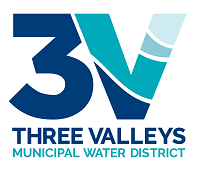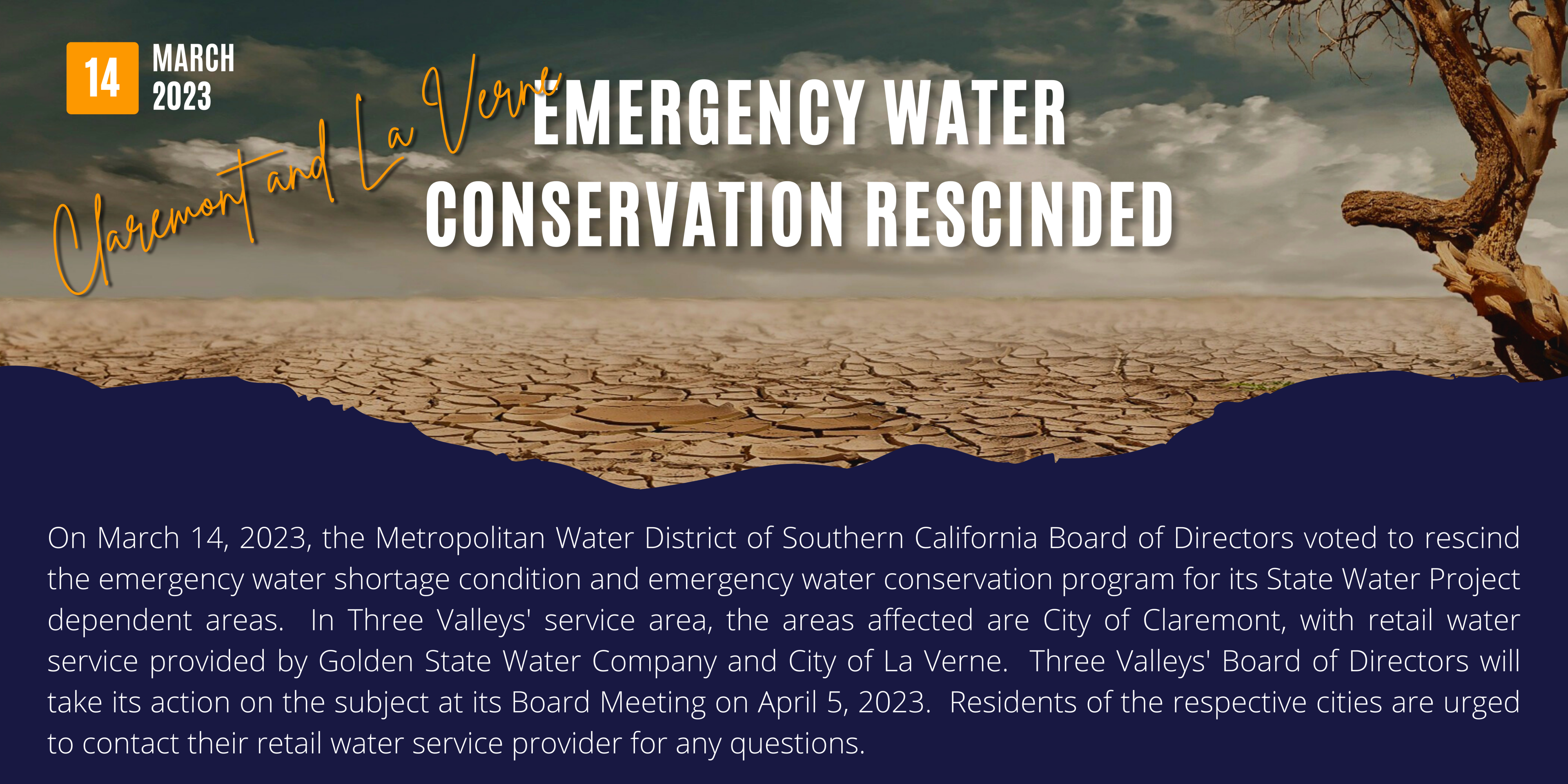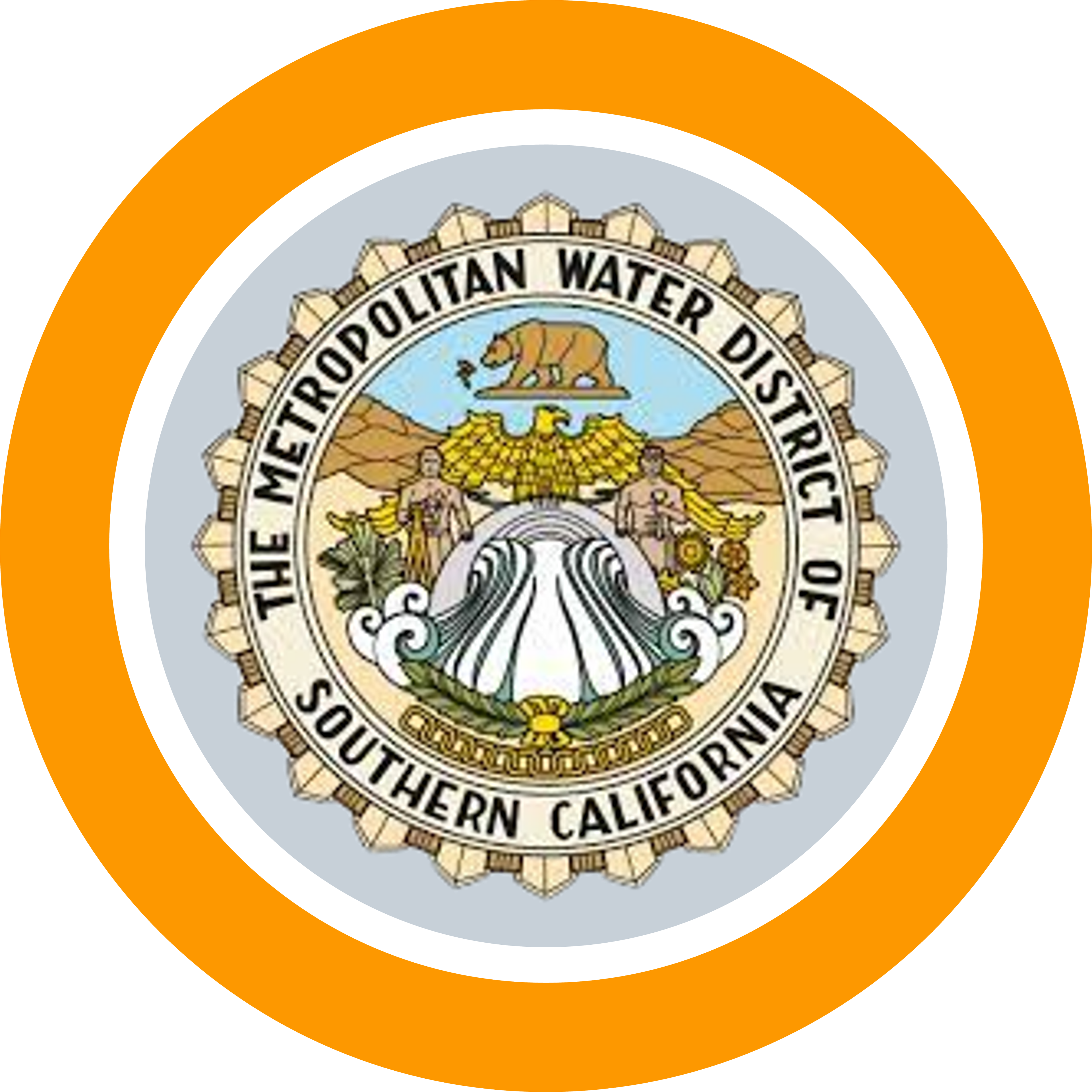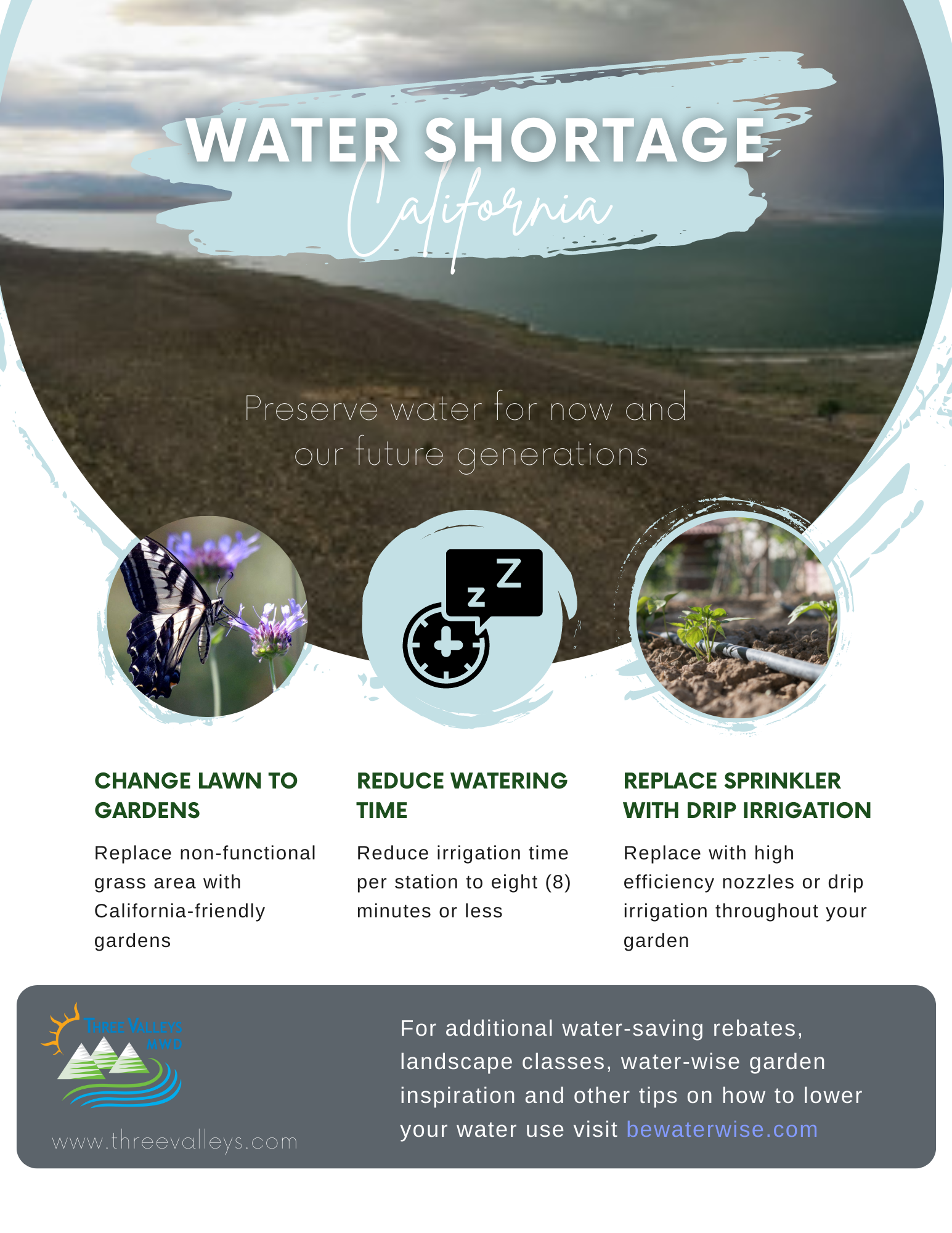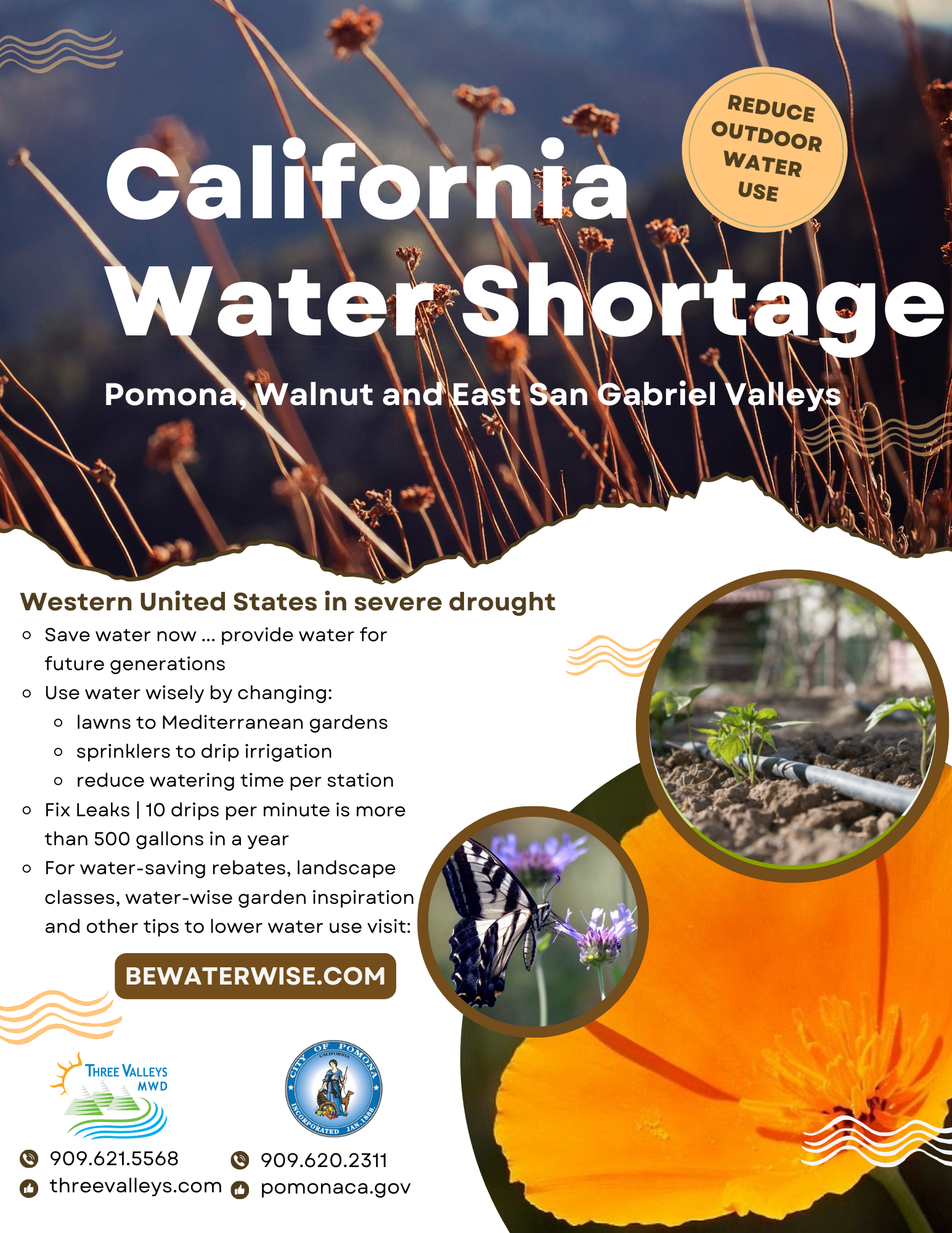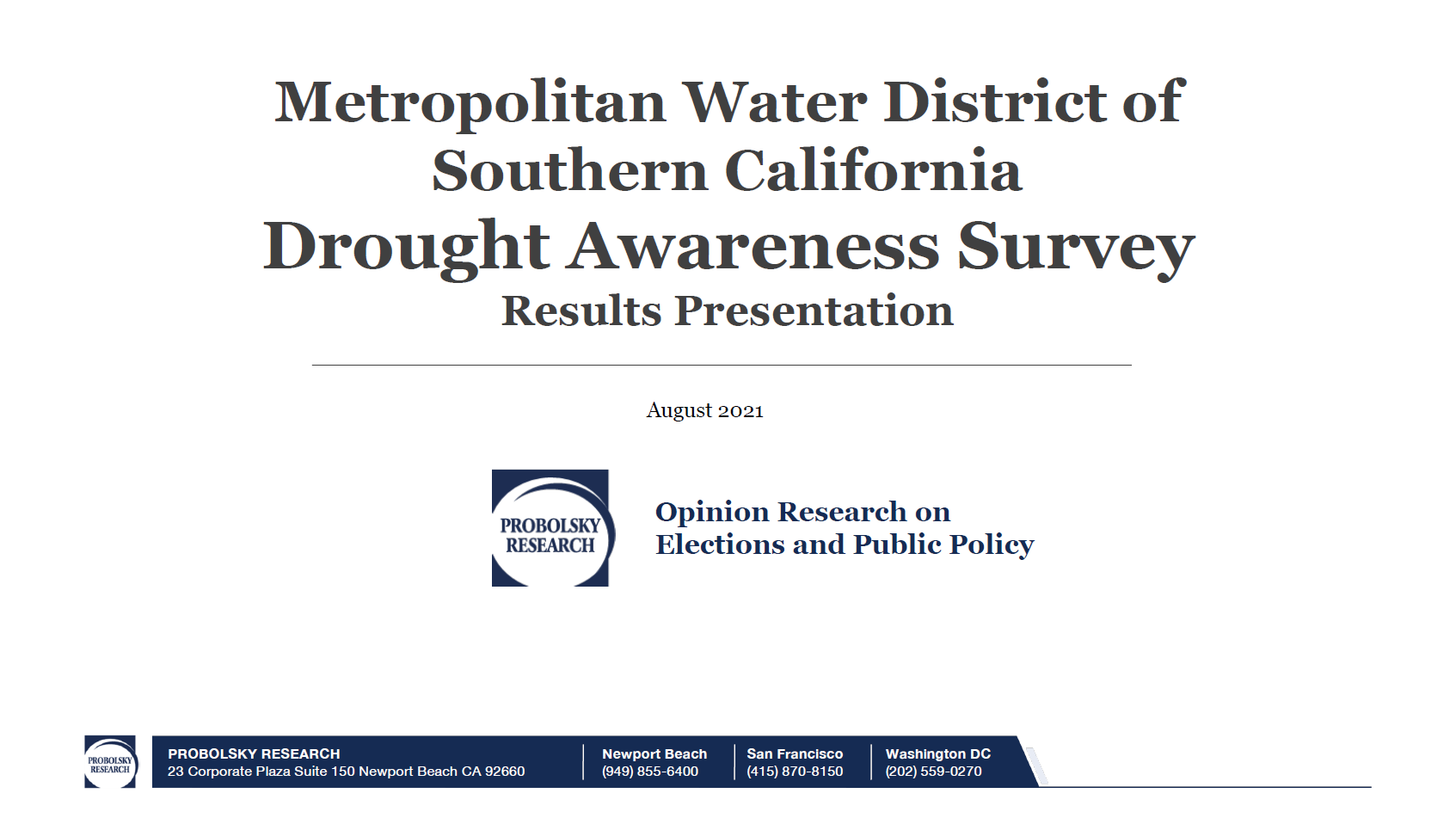Conservation
Conservation & Rebate Resources
Three Valleys Announces Water Shortage Contingency Plan-Level 5 in its State Water Project Constrained Areas
April 21, 2022
Claremont, CA — The Three Valleys Municipal Water District (TVMWD) board voted yesterday to move to a Water Shortage Contingency Plan (WSCP) - Level 5 in its State Water Project (SWP) constrained areas, urging up to a 50% reduction in water use in these particular areas.
The TVMWD board previously declared in November 2021 a Shortage Level 2, calling for up to a 20% reduction in water use in its entire service area. TVMWD delivers approximately 60,000 acre-feet of imported water from Metropolitan Water District of Southern California (MWD). TVMWD’s Miramar Water Treatment Plant in Claremont receives 100% of its imported water from the SWP, approximately 20,000 acre feet of water per year. The remaining two-thirds of the imported water delivered by TVMWD is received from MWD through its Colorado River supplies.
After a third consecutive year of exceptional drought, the California Department of Water Resources (DWR) announced last month a reduction in the SWP allocation to five percent. Subsequently, DWR issued requirements to provide additional water to meet human health and safety needs for the agencies that are solely dependent on the SWP supplies if the agencies were to implement robust conservation efforts with mandatory requirements. Local agencies will be challenged to meet demands in the constrained areas that can only receive SWP supplies and do not have connections to the Colorado River supply. The constrained area of TVMWD includes the cities of Claremont and La Verne.
Governor Gavin Newsom has called upon each urban water supplier, per California Water Code section 10632, to adopt shortage levels between twenty and thirty percent based on local conditions.
Agencies that currently receive SWP supplies at connections within the constrained SWP Dependent Area must implement and enforce a restriction on outdoor watering of no more than one day per week. Hand watering of trees would be exempt from the one-day-per-week restriction, along with drip irrigation systems and established fire hazard zones. MWD, the largest wholesale supplier of SWP water in the region, announced that if an agency either does not submit an acceptable plan to limit outdoor watering or if it inadequately enforces the plan, a penalty of up to $2,000 per acre-foot shall be assessed on all SWP supplies delivered to that non-compliant agency. However, agencies can avoid these outdoor watering restrictions and penalties by taking sufficient action to entirely eliminate its use of SWP supplies and switching to either local supplies or Colorado River supplies.
“This extreme reduction in our Northern California supplies means we all must increase our conservation efforts and cutbacks in water use. I am pleased to say this message has been aggressively acted upon by the retail member agencies we serve,” stated Matthew Litchfield, General Manager for TVMWD.

Metropolitan Proposed Emergency Drought Actions
April 8, 2022
The Drought Emergency is Becoming Much More Severe
- Now in our third year of an historic drought, California just endured the driest January, February and March in recorded history. Normally these are the state’s wettest months.
- Southern California water agencies that depend on the State Water Project are facing immediate and dire challenges due to extremely limited supplies this year.
Outdoor Watering Would Be Cut to One Day a Week for Six Million Southern Californians
- Metropolitan has declared a drought emergency in the many Southern California communities that are dependent on the State Water Project for their supplies. This includes about one-third of Southern California’s population in portions of Los Angeles, Ventura and San Bernardino counties.
- Outdoor watering in these areas may be restricted to one day a week under recommendations before Metropolitan’s board. The proposed plan, which would be finalized in late April, will also include financial penalties for non-compliance and non-enforcement of these new rules.
- If enough water isn’t conserved through these actions, or if water supply conditions worsen, outdoor watering could be eliminated.
Conservation is Needed to Get Through This Drought
- The situation is extremely serious. All Southern Californians must cut back their water use by 20 percent to stretch available supplies and storage.
- Metropolitan is working closely with its member agencies. We’re in this together – and if we all reduce our water use, we can get through this drought. Every drop counts.
- To support conservation, Metropolitan has expanded its rebate programs and offers many indoor and outdoor water-saving tips on bewaterwise.com.
- While we address these immediate challenges, Metropolitan is also committed to taking bold actions to adapt to climate change, including investing in local supplies, storage, system flexibility and making conservation a way of life.
First-ever Colorado River water shortage is now almost certain, new projections show
(CNN) Thousands of people will celebrate Memorial Day this weekend on the water of Lake Mead, just 24 miles east of Las Vegas on the border of Arizona and Nevada.
What they may not realize is that the oasis they're enjoying in the desert is entering unchartered territory, with significant ramifications for millions across the Southwest in the years to come.
Drought ravages California's reservoirs ahead of hot sumer
OROVILLE, Calif. (AP) — Each year Lake Oroville helps water a quarter of the nation’s crops, sustain endangered salmon beneath its massive earthen dam and anchor the tourism economy of a Northern California county that must rebuild seemingly every year after unrelenting wildfires.
But now the mighty lake — a linchpin in a system of aqueducts and reservoirs in the arid U.S. West that makes California possible — is shrinking with surprising speed amid a severe drought, with state officials predicting it will reach a record low later this summer.
2023 Drought Conditions
(March 2023)
As we begin to enter warmer months in drought conditions, communicating with our member agencies and membership associations is essential to providing insight into our service areas ongoing preparedness for climate resiliency. This is also an opportunity to highlight the need for more statewide and local investments in water infrastructure and resiliency.
Investments In Infrastructure Increase Water Supply Reliability
- Together with our member agencies, Three Valleys Municipal Water District (TVMWD) has invested millions of dollars into developing and managing drought-resilient water supplies, specifically with the building of wells to increase the local groundwater supply.
- Planning for periodic dry years and drought is part of responsible water management in California. Water agencies throughout the state have developed plans to address climate change.
- In addition to local investment, action must be taken at the state and federal levels to improve our aging water infrastructure to realize a more reliable, resilient water supply for our residents and to maintain the food supply as the extremes of climate change grow more severe.
- Uncertainties, such as new regulations, natural disasters and unpredictable climate are constant reminders of how important it is to invest in increased statewide storage and diversified water supplies.
- It often takes 10 years or longer to realize the benefits of investments into more resilient and reliable water supplies.
California Drought Statistics/Supplies
- 2021 marked the third driest year on record, as the annual water year drew to a close early this spring, the state’s current snowpack was less than twothirds of normal for this date in the Northern and Central Sierras and well under 50% for Southern Sierra. Ongoing weather conditions will play a large part in determining how California will be impacted. (Check DWR’s website for updated figures.)
- During this time California’s reservoir conditions vary throughout the state: Lake Shasta, the state’s largest reservoir located in Northern California, was at 45% of capacity (52% of historical average); San Luis Reservoir in Central California was at 45% of capacity (55% of historical average); Castaic Lake was at 68% of capacity (76% of historical average). (Statistics are as of May 25, 2021. Check DWR’s website for updated figures.)
- Through our wholesale water supplier Metropolitan Water District (MWD), TVMWD will assess conditions on an ongoing basis to ensure we have sufficient water supplies for the community and will keep customers informed as the situation changes.
Long-term Water Efficiency Remains a Way of Life
- During the 2012-2016 drought, TVMWD member agencies significantly reduced water use and currently use less water than those pre-drought levels thanks to increased awareness about water efficiency and use of various MWD and local conservation rebate and incentive programs. This long-term change will help our service area undergo what may be the second dry winter in a row. Rev. March 2023
- California has experienced many periods of drought and weather extremes due to climate change, which will continue to occur more frequently. Continuing to make water efficiency a California way of life will help the state stay prepared for all climactic extremes.
- As we move into the hotter, summer months, we will continue to promote the efforts of our member agencies for their ongoing water-use efficiency achievements and encourage them to keep using water wisely as a way of life in California.
- TVMWD values efficient water use and offers customers numerous rebate and incentive programs to be more water efficient.
- Californians can practice water efficiency year-round and make a difference by finding and fixing leaks, taking shorter showers and installing California-friendly landscapes.
|
||||||||
|
